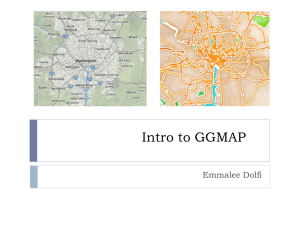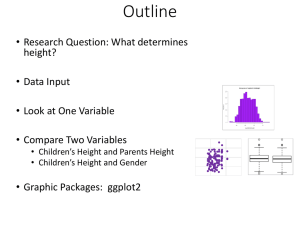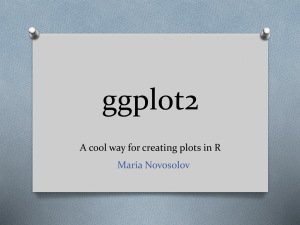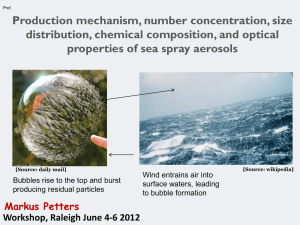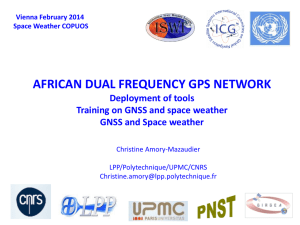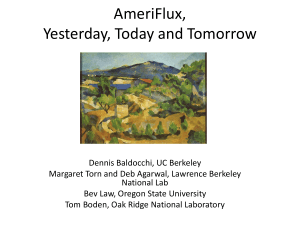data - Columbia University
advertisement
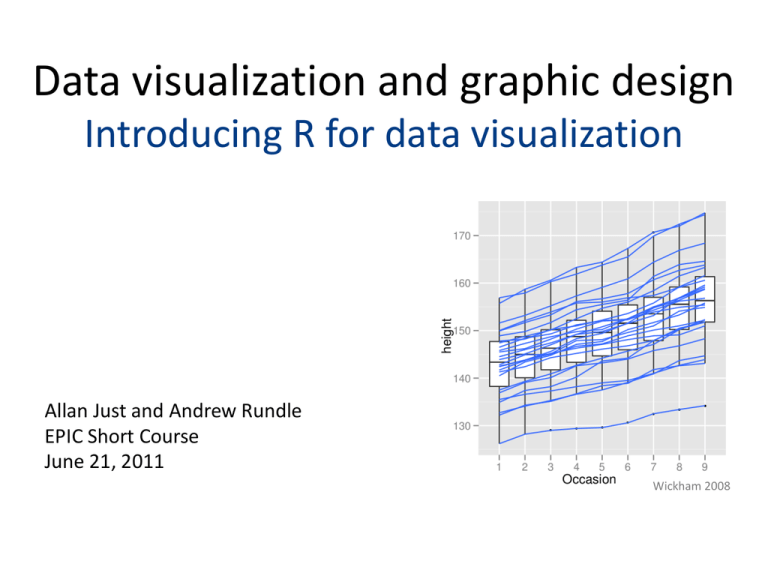
Data visualization and graphic design
Introducing R for data visualization
Allan Just and Andrew Rundle
EPIC Short Course
June 21, 2011
Wickham 2008
Intro to R
Objectives
After this class, participants will be able to:
1. Describe some capabilities and uses of R
2. Search for help within R and use good coding practices for
reproducible research in R
3. Read in and summarize a simple dataset with
R/JGR/Deducer
4. Make some standard plots with Deducer templates
What is R?
nytimes.com
R has many uses
• Work with data: subset, merge, and transform
datasets with a powerful syntax
• Analysis: use existing statistical functions like
regression or write your own
• Graphics: graphs can be made quickly during
analysis and polished for publication quality
displays
Why learn a whole language to
look at data versus Excel?
1. Recreate/redo your exact analysis
2. Automate repetitive tasks
3. Access to statistical methods not available in Excel
4. Graphs are more elegant
1. It's free!
Why R versus
SAS, SPSS, or Stata?
2. It runs on Mac, Windows, and Linux
3. It has state-of-the-art graphics capabilities
4. It contains advanced statistical routines not yet available
in other packages – a de facto standard in statistics
5. Can program new statistical methods or automate data
manipulation/analysis
adapted from statmethods.net
Made in SAS
Redone in R
learnr.wordpress.com
R plots from my own research
Scatterplot matrix
bivariate densities and correlations
Forest plot to compare parameter estimates
from many models
Displaying lots of data: facetted histograms
Plotting data with a model
Automated report generation
Choropleth map
Shapefile: CIESIN, Columbia University
Asthma data: http://nyc.gov/html/doh/downloads/pdf/asthma/asthma-hospital.pdf
Intro to R: recap
Objectives
After this class, participants will be able to:
1. Describe some capabilities and uses of R
Statistical data analysis
Automation (scripting) of functions to work with data
Elegant graphics to facilitate data visualization
2. Search for help within R and use good coding practices for
reproducible research in R
3. Read in and summarize a simple dataset with R/JGR/Deducer
4. Make some standard plots with Deducer templates
Learning a new language is difficult
flickr.com/photos/dnorman/373
What makes R difficult to learn
R is designed to be flexible and powerful rather
than simple but limited.
R is a fully featured language mainly used
from the command line. Learning the
commands and the structure of the code takes
time and practice.
If I made a a typo you would know what I
meant...
What makes R difficult to learn
R is designed to be flexible and powerful rather
than simple but limited.
The solution:
be careful
build code in simple pieces and test as you go
(learn to debug).
Reuse code that works.
Use helpful resources.
Consider an alternative GUI for R.
Getting help in R
You can call for help on a function with a leading
question mark and leaving off the ()
?functionname
Search online
statmethods.net
An Introduction to R
in Windows found under Help – Manuals (in PDF)
Suggestions for an R workflow
Save the bits of your code that work in a text editor - building
a script of clean code that works from start-to-finish.
With clean code instead of transformed data files it is easier
to redo analyses if your data are updated or you want to
change an earlier step
Leave yourself informative comments
#
#
everything to the right of the pound sign
is unevaluated
Using spaces and indents can help readability
Use meaningful names for objects
Reproducible research!
Intro to R: recap
Objectives
After this class, participants will be able to:
1. Describe some capabilities and uses of R
2. Search for help within R and use good coding practices for
reproducible research in R
?t.test
will bring up R help
Free manuals online: Introduction to R Also: statmethods.net
#use comments; save the code that works to reproduce your results
3. Read in and summarize a simple dataset with R/JGR/Deducer
4. Make some standard plots with Deducer templates
Learning the language
Many important features
• Arithmetic and logical operators: +, <, …
• Data types: numeric, logical, …
• Data structures: vectors, matrices, …
• Functions – always end with (): median(x)
Using R as a calculator
Mathematical operators
+ - / * ^
log()
abs()
R can evaluate logical expressions
==
!=
&
|
equal
not equal
and
or (vertical pipe)
10 < 20
[1] TRUE
pi > 3 & 2^2 == 4
[1] TRUE
"This" != "That"
[1] TRUE
Creating new objects
Assignment operator is <- (looks like an arrow)
x <- 10
“Set x to take the value 10”
The symbols in this operator must be adjacent.
x < - 10
What does this do?
You can overwrite old values
x <- x^2
“Set x to take the value x2”
Indexing and subsetting
Concatenate function is c()
x <- c(10, 20, 30)
x
[1] 10 20 30
Refer to components of objects by a position index which goes
between square braces
x[2]
return the second position in x
[1] 20
x[c(1, 2)]
return the first and second position in x
[1] 10 20
x[-3]
return all except the third position in x
[1] 10 20
What would x[c(3, 2)] return?
Data frames
A data frame is a rectangular collection of data
Rows: observations
Columns: variables
diamonds <- data.frame(carat, cut, price)
1
2
3
4
5
6
carat
cut price
0.23
Ideal
326
0.21
Premium
326
0.23
Good
327
0.29
Premium
334
0.31
Good
335
0.24 Very Good
336
Data frames
You can extract the variables as vectors with a $
diamonds$cut
You can also index by position (or name) with square braces
diamonds[2, 3] returns the single value in row 2, column 3
row, column
An empty index is treated like a wildcard and corresponds to all
rows or columns depending on position
diamonds[, "cut"] (same result as diamonds$cut)
How would you return the first three rows and all columns?
R functions
Thousands of functions are built-in:
median()
lm() linear model
t.test()
chisq.test()
or make your own:
inch.to.cm <- function(x){x * 2.54}
inch.to.cm(74)
[1] 187.96
Missing values
These take a value of NA
Can be in a data object of any type (logical, numeric, character)
By default operations on NA will return NA
NA == NA
[1] NA
Can check for NA with is.na()
y <- c(2, 10, NA, 12)
is.na(y)
[1] FALSE FALSE TRUE FALSE
Can often pass na.rm = T option to remove NA values in operations
mean(y)
[1] NA
mean(y, na.rm = T)
[1] 8
R has several thousand
additional packages
time series
survival
spatial
machine learning
bioinformatics
Interfaces to Excel, SQL databases, Twitter,
google maps…
Installing a package
1. Open up R
2. Click in to the console window and type:
install.packages()
3. Select a mirror (anywhere in the US)
4. Find and select "Deducer" and choose OK.
5. This will download Deducer and the other
packages which it requires, including ggplot2.
The default R graphical user interface
(Windows)
JGR
Deducer
Recap on GUIs
R
Default Windows GUI: lacks additional features to
make learning or programming easier
JGR: Makes programming easier with syntax
highlighting and command argument suggestions.
No menus for stats. Looks the same across
platforms (Java based)
Deducer: Adds menus for basic stats to JGR. Menu
driven graphics options (building with ggplot2).
R graphics – 3 main "dialects"
Base: with(airquality, plot(Temp, Ozone))
Lattice: xyplot(Ozone ~ Temp, airquality)
ggplot2:
ggplot(airquality, aes(Temp, Ozone)) + geom_point( )
Google image search: ggplot2
ggplot2 philosophy
Written by Hadley Wickham (Rice Univ.)
Extends The Grammar of Graphics (Wilkinson, 2005)
All graphs can be constructed by combining
specifications with data (Wilkinson, 2005).
A specification is a structured way to describe how to
build the graph from geometric objects (points, lines,
etc.) projected on to scales (x, y, color, size, etc.)
ggplot2 philosophy
When you can describe the content of the graph with
the grammar, you don’t need to know the name of a
particular type of plot…
Dot plot, forest plot, Manhattan plot are just special cases of
this formal grammar.
…a plotting system with good defaults for a large set of
components that can be combined in flexible and
creative ways…
Building a plot in ggplot2
data to visualize (a data frame)
map variables to aesthetic attributes
geometric objects – what you see (points, bars, etc)
scales map values from data to aesthetic space
faceting subsets the data to show multiple plots
statistical transformations – summarize data
coordinate systems put data on plane of graphic
Wickham 2009
A basic ggplot2 graph
ggplot(airquality) + geom_point(aes(x = Temp, y = Ozone))
Data
Aesthetics map variables to scales
Geometric objects to display
A ggplot2 graph is an R object
p <- ggplot(airquality) + geom_point(aes(x = Temp, y = Ozone))
str(p) #structure of p
List of 8
$ data
:'data.frame':
153 obs. of 6 variables:
..$ Ozone : int [1:153] 41 36 12 18 NA 28 23 19 8 NA ...
..$ Solar.R: int [1:153] 190 118 149 313 NA NA 299 99 19 194 ...
..$ Wind
: num [1:153] 7.4 8 12.6 11.5 14.3 14.9 8.6 13.8 20.1 8.6 ...
..$ Temp
: int [1:153] 67 72 74 62 56 66 65 59 61 69 ...
..$ Month : int [1:153] 5 5 5 5 5 5 5 5 5 5 ...
..$ Day
: int [1:153] 1 2 3 4 5 6 7 8 9 10 ...
$ layers
:List of 1
..$ :proto object
.. .. $ mapping
:List of 2
.. .. ..$ x: symbol Temp
.. .. ..$ y: symbol Ozone
.. .. $ geom_params:List of 1
.. .. ..$ na.rm: logi FALSE
.
.
.
$ plot_env
:<environment: R_GlobalEnv>
- attr(*, "class")= chr "ggplot"
Note that the internal plot
specification includes the data
So if you update the data,
update the call to ggplot()
Help with learning ggplot2
Website:
had.co.nz/ggplot2/
Thousands of examples!
Book:
ggplot2: Elegant Graphics for
Data Analysis
Hadley Wickham, 2009
Graphic User Interface:
Deducer (R package)
Ian Fellows
Intro to R: recap
Objectives
After this workshop participants will be able to:
1. Describe some capabilities and uses of R
2. Search for help within R and use good coding practices for
reproducible research in R
3. Read in and summarize a simple dataset with R/JGR/Deducer
Together, let’s explore some data from the WHO - Global
School Health Survey.
I will also give you a script containing code which you can run,
modify, and take home!
4. Make some standard plots with Deducer templates
Open JGR -
Load the Deducer package
Note additional menus
Intro to R: recap
Objectives
After this workshop participants will be able to:
1. Describe some capabilities and uses of R
2. Search for help within R and use good coding practices for
reproducible research in R
3. Read in and summarize a simple dataset with R/JGR/Deducer
4. Make some standard plots with Deducer templates
Using the gshs dataframe – let's make some plots together using
templates in:
Deducer → Plots → Plot Builder
Since R, JGR, and Deducer are free,
you should install them at home or
work and play with them!
Installing R, JGR, Deducer
Part I: R on Windows (shown), or Mac, or Linux
R is available from a set of mirrors known as The
Comprehensive R Archive Network (CRAN)
http://cran.r-project.org/
Closest mirror and link for windows:
http://software.rc.fas.harvard.edu/mirrors/R/bin/windows/base/
Uses a Windows installer – default options are fine
Installing R, JGR, Deducer
Part II: JGR on Windows (shown), or Mac, or Linux
JGR requires a Java Development Kit (JDK)
You probably don't have this*
Available free at:
http://www.oracle.com/technetwork/java/javase/downloads/index.html
*if you did have a JDK (and not just a JRE)
you would have a folder named something like …
C:\Program Files\Java\jdk1.6.0_20\
Installing R, JGR, Deducer
Part II: JGR on Windows (shown), or Mac, or Linux
JGR requires a launcher file on Windows:
http://www.rforge.net/JGR/web-files/jgr-1_62.exe
Leave this as your desktop shortcut
Installing R, JGR, Deducer
Part III: Installing Deducer
Deducer is an R package
From within JGR
To install packages: Packages & Data -> Package Installer
To load packages: Packages & Data -> Package Manager
A few helpful R links
Download R: http://cran.r-project.org/ available for Windows, Mac OS X, and Linux
Advice – A clearly stated question with a reproducible example is far more likely to get help. You will often find your own solution by restating
where you are getting stuck in a clear and concise way.
Writing reproducible examples: https://gist.github.com/270442
General R links
http://statmethods.net/
Quick-R for SAS/SPSS/Stata Users - An all around excellent reference site
http://www.ats.ucla.edu/stat/R/
Resources for learning R from UCLA with lots of examples
http://www.r-bloggers.com/learning-r-for-researchers-in-psychology/ This is a nice listing of R resources
http://stackoverflow.com/questions/tagged/r
Q&A forum for R programming questions - lots of good help!
see also: http://crossvalidated.com for general stats & R
http://rstudio.org
Integrated Development Environment for command line programming with R
ggplot2 links
http://had.co.nz/ggplot2/
http://groups.google.com/group/ggplot2
https://github.com/hadley/ggplot2/wiki
ggplot2 help & reference – lots of examples
ggplot2 user group – great for posting questions
ggplot2 wiki: answers many FAQs, tips & tricks
http://www.slideshare.net/hadley/presentations
Over 100 presentations by Hadley Wickham, author of ggplot2.
A four-part video of a ½ day workshop by him starts here: http://had.blip.tv/file/3362248/
Setting up JGR in Windows
JGR requires a JDK – speak to your IT person if this seems daunting (http://www.oracle.com/technetwork/java/javase/downloads/index.html)
On Windows, JGR needs to be started from a launcher. For R version 2.13.0 on Windows with a 32bit R you will likely want to get the file jgr1_62.exe as a launcher from here: http://www.rforge.net/JGR/
A discussion of the features of JGR can be found in this article (starting on page 9):
http://stat-computing.org/newsletter/issues/scgn-16-2.pdf
Deducer - an R package which works best in a working instance of JGR – has drop-down menus for ggplot2 functionality
http://www.deducer.org/pmwiki/pmwiki.php?n=Main.DeducerManual
There are great videos linked here introducing the Deducer package (although the volume is quite low)
This slide last updated 06/19/2011
